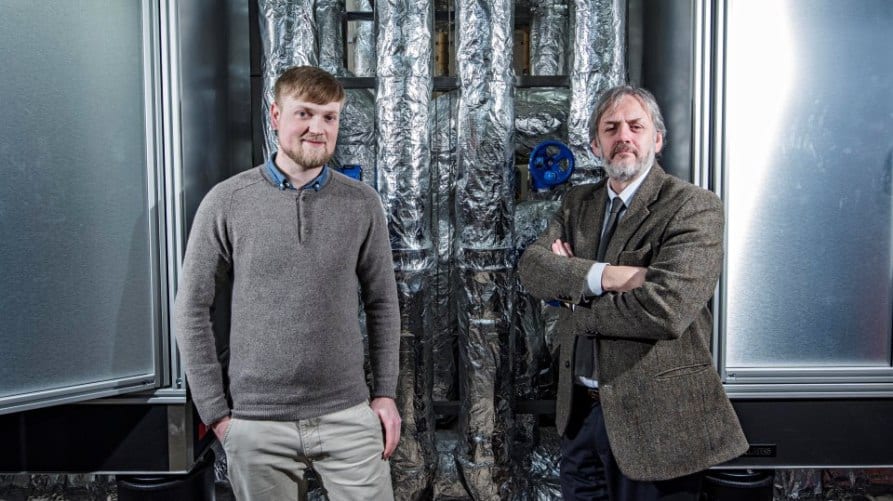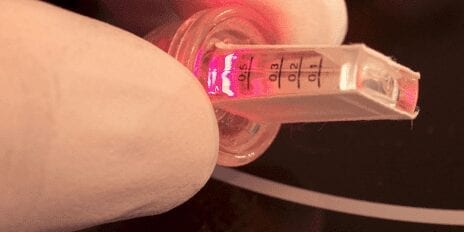
Photo: Rob Matheson/MIT
In the fall of 1999, a young chemical engineer named Todd Zion left his job at Eastman Kodak to enroll in the Ph.D. program at the Massachusetts Institute of Technology.
While looking for a subject to research, Zion noticed a grant proposal, never funded, that another graduate student had written on the subject of drug delivery. One possibility mentioned in the proposal was the development of a kind of insulin that would automatically respond to changes in blood-sugar levels, becoming active only when needed to maintain healthy levels around the clock. If it worked, the sugar-sensitive version could transform the lives of the six million people with diabetes in the United States who use insulin. No longer would they have to test their blood-sugar levels multiple times per day and try to calculate how much insulin to take. The self-regulating insulin would curtail high sugar levels, which raise the risk of long-term complications, and eradicate, or at least reduce, the most dangerous short-term complication: hypoglycemia, when sugar levels fall so low that they can cause confusion, unconsciousness, seizures and even death.
“I thought, Wow, that is a really neat area in which to do research,” Zion told me. Other researchers had been trying for 20 years to make insulin work only when needed. The first to publish a study were the scientists Michael Brownlee and Anthony Cerami, who in 1979 embedded a sugar-encrusted form of insulin in a mesh pouch with a sugar-loving protein called lectin. The idea was that when blood-sugar levels were elevated, the lectin would bind to the sugar in the blood and allow the insulin to leak out; when sugar levels were normal, the lectin would bind to the sugar-encrusted insulin, keeping it inside the pouch. But the system was impractical, because the pouch would need to be implanted under the skin and periodically refilled. And the lectin, derived from the jack-bean plant, was toxic.
In his first three years at M.I.T., Zion used nanoscale molecular engineering to create an insulin-lectin gel that could be injected without the need for an implanted pouch, while also rejiggering the lectin to make it less toxic. “It worked great visually,” he said. When the gel was placed in a sugar solution, “you could see the outer edge getting clear and dissolving . . . almost like an ice cube melting in water.”
The problem was that, no matter how hard he tried to manipulate the gel, the insulin either leaked out too easily, even when sugar levels were low, or not easily enough, when sugar levels were high.
Zion knew there was another approach: changing the insulin molecule itself, to make it sensitive to blood-sugar levels directly. But, he said, “almost everyone in the field of drug discovery believed that you should never, ever change the insulin molecule. . . . From a regulatory point of view, as soon as you manipulate the molecule, you’ve created a new drug. It doesn’t matter if you’ve attached a single atom to it.” Doing so, he knew, would require years of clinical trials in preparation for a new-drug application submission to the F.D.A. “That’s the only reason people were afraid.”
Zion’s trick was to attach a chemical arm — a short chain of sugars — directly onto the insulin molecule. (Attaching sugar to insulin? “Yes, it is a bit ironic,” he concedes.) The beauty of this approach is that it permits the insulin to latch directly onto the sugar-loving lectin in the gel — but only as needed. When blood-sugar levels are high, the lectin hooks up with any sugar floating freely from the blood, allowing the insulin molecule to do its normal job of connecting with insulin receptors on the surface of cells. (That is how insulin lowers blood-sugar levels, by merging with a cell’s insulin receptor and unlocking the cell membrane to allow sugar in.) When the sugar gets swallowed up by cells, lowering levels in the blood, the only remaining sweet for the lectin to attach to is the altered insulin’s sugar arm. Handcuffed to the lectin, the insulin can’t bind to insulin receptors. And so the insulin stops working to lower blood-sugar levels precisely when it’s no longer needed, because its sugar chain is held hostage by the lectin.
Zion called his new chemical creation smart insulin. In 2003, after testing it in rats, he won M.I.T.’s annual Entrepreneurship Competition. With the $30,000 prize money, he started a company called SmartCells and tried to see if he could make it work well enough to test it in humans.
The Latest on: Inventing drugs
[google_news title=”” keyword=”Inventing drugs” num_posts=”10″ blurb_length=”0″ show_thumb=”left”]
via Google News
The Latest on: Inventing drugs
- 8 Sci-Fi Movie Inventions Ruined By Real Scienceon April 29, 2024 at 4:20 pm
Holograms and cryogenic stasis may look cool in movies, but real-life science still has a long way to go to make them a reality.
- Oregon Republicans visit Arizona-Mexico border to learn about immigration, securityon April 29, 2024 at 8:47 am
The lawmakers say lax security around the southern border exacerbates the drug crisis in Oregon, 1,000 miles north.
- Report: ‘Tech Bros’ are Microdosing Psychedelics in Droveson April 29, 2024 at 7:23 am
Then Google co-founder Sergey Brin opened up about microdosing psilocybin. Psilocybin microdosing is the repeated self-administration of mushrooms at doses small enough to not induce hallucinations ...
- What making weight-loss drugs mean for the environmenton April 28, 2024 at 5:00 pm
The drugs regulate blood sugar levels and reduce appetite ... Companies have been using SPPS ever since Bruce Merrifield introduced it in the 1960s—an invention for which he won the Nobel Prize in ...
- Oregon Republicans to visit Arizona-Mexico border to learn about security issueson April 27, 2024 at 2:14 pm
Sixteen Republican lawmakers and legislative candidates from Oregon plan to visit the Arizona-Mexico border on Monday, arguing that lax security around the southern border exacerbates the drug crisis ...
- GUEST COLUMN: Collateral damage — American innovationon April 26, 2024 at 4:00 am
The Biden administration recently proposed misinterpreting a decades-old law to try to lower drug prices. But as multiple studies have already shown, the White House’s plan would do nothing to ...
- Tetra Pharm Technologies and Glysious Announce Collaboration to Develop Transdermal Combination Drugs Targeting the Endocannabinoid Systemon April 24, 2024 at 12:16 am
Tetra Pharm Technologies has focused intensively on formulation expertise, that is, how the molecules are effectively integrated with a drug delivery system to reach their desired targets. Glysious ...
- Supreme Court will not hear D.C. biotech's patent infringement appealon April 23, 2024 at 12:23 pm
Future drug sales at one D.C. biotech stand to decline after the Supreme Court rejected its request to review its patent infringement lawsuit against a pair of competitors.
- U.S. Supreme Court rejects Vanda Pharmaceuticals case over sleep-drug patentson April 22, 2024 at 8:46 am
The U.S. Supreme Court on Monday declined to hear a bid by Vanda Pharmaceuticals to revive patents for its sleep-disorder drug Hetlioz that were previously declared invalid in a dispute with generic ...
- 60 years ago, the World's Fair showcased dazzling inventions and international cultureson April 22, 2024 at 5:24 am
The fair, at Flushing Meadows-Corona Park in Queens, was a seminal moment in people's lives, a glimpse of what that future might hold and a celebration of color, culture, food and technological ...
via Bing News










